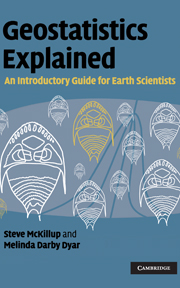Book contents
- Frontmatter
- Contents
- Preface
- 1 Introduction
- 2 “Doing science”: hypotheses, experiments and disproof
- 3 Collecting and displaying data
- 4 Introductory concepts of experimental design
- 5 Doing science responsibly and ethically
- 6 Probability helps you make a decision about your results
- 7 Working from samples: data, populations and statistics
- 8 Normal distributions: tests for comparing the means of one and two samples
- 9 Type 1 and Type 2 error, power and sample size
- 10 Single-factor analysis of variance
- 11 Multiple comparisons after ANOVA
- 12 Two-factor analysis of variance
- 13 Important assumptions of analysis of variance, transformations and a test for equality of variances
- 14 Two-factor analysis of variance without replication, and nested analysis of variance
- 15 Relationships between variables: linear correlation and linear regression
- 16 Linear regression
- 17 Non-parametric statistics
- 18 Non-parametric tests for nominal scale data
- 19 Non-parametric tests for ratio, interval or ordinal scale data
- 20 Introductory concepts of multivariate analysis
- 21 Introductory concepts of sequence analysis
- 22 Introductory concepts of spatial analysis
- 23 Choosing a test
- Appendices
- References
- Index
16 - Linear regression
Published online by Cambridge University Press: 05 June 2012
- Frontmatter
- Contents
- Preface
- 1 Introduction
- 2 “Doing science”: hypotheses, experiments and disproof
- 3 Collecting and displaying data
- 4 Introductory concepts of experimental design
- 5 Doing science responsibly and ethically
- 6 Probability helps you make a decision about your results
- 7 Working from samples: data, populations and statistics
- 8 Normal distributions: tests for comparing the means of one and two samples
- 9 Type 1 and Type 2 error, power and sample size
- 10 Single-factor analysis of variance
- 11 Multiple comparisons after ANOVA
- 12 Two-factor analysis of variance
- 13 Important assumptions of analysis of variance, transformations and a test for equality of variances
- 14 Two-factor analysis of variance without replication, and nested analysis of variance
- 15 Relationships between variables: linear correlation and linear regression
- 16 Linear regression
- 17 Non-parametric statistics
- 18 Non-parametric tests for nominal scale data
- 19 Non-parametric tests for ratio, interval or ordinal scale data
- 20 Introductory concepts of multivariate analysis
- 21 Introductory concepts of sequence analysis
- 22 Introductory concepts of spatial analysis
- 23 Choosing a test
- Appendices
- References
- Index
Summary
Introduction
This chapter explains simple linear regression analysis. The different uses of correlation and regression were contrasted in Chapter 15. Correlation examines if two variables are related. Regression describes the functional relationship between a dependent and an independent variable.
Linear regression
Linear regression analysis is often used by earth scientists. For example, the equation for the regression of one variable on another may suggest hypotheses about why the two variables are related. More practically, regression can be used in situations where the dependent variable is difficult, expensive or impossible to measure, but its values can be predicted from another easily measured variable to which it is functionally related. Here is an example.
It can be quite difficult to measure the temperature of an erupting magma. In situ measurements can be made if you can safely get close enough to lower a sheathed thermocouple into the hot lava, but this is a dangerous undertaking. Optical pyrometers can be used to estimate magma temperatures from any distant position with a direct line of sight, but corrections for distance, elevation and air temperatures must be applied.
Fortunately, it has been shown that the SiO2 content of the magma varies inversely with eruption temperature: basaltic magmas tend to erupt at hotter temperatures (~1200–1300 °C) and more silicic ones at cooler temperatures (~700–800 °C). So eruption temperature can be predicted from the SiO2 content of the cooled magma, which can be accurately (and safely) measured in the laboratory after the eruption.
- Type
- Chapter
- Information
- Geostatistics ExplainedAn Introductory Guide for Earth Scientists, pp. 204 - 226Publisher: Cambridge University PressPrint publication year: 2010



